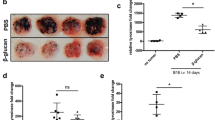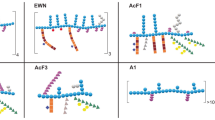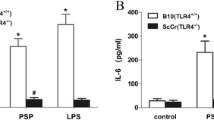Abstract
Fungi of the genus Ganoderma are basidiomycetes that have been used as traditional medicine in Asia and have been shown to exhibit various pharmacological activities. We recently found that PS-F2, a polysaccharide fraction purified from the submerged culture broth of Ganoderma formosanum, stimulates the maturation of dendritic cells and primes a T helper 1 (Th1)-polarized adaptive immune response in vivo. In this study, we investigated whether the immune adjuvant function of PS-F2 can stimulate antitumor immune responses in tumor-bearing mice. Continuous intraperitoneal or oral administration of PS-F2 effectively suppressed the growth of colon 26 (C26) adenocarcinoma, B16 melanoma, and sarcoma 180 (S180) tumor cells in mice without adverse effects on the animals’ health. PS-F2 did not cause direct cytotoxicity on tumor cells, and it lost the antitumor effect in mice with severe combined immunodeficiency (SCID). CD4+ T cells, CD8+ T cells, and serum from PS-F2-treated tumor-bearing mice all exhibited antitumor activities when adoptively transferred to naïve animals, indicating that PS-F2 treatment stimulates tumor-specific cellular and humoral immune responses. These data demonstrate that continuous administration of G. formosanum polysaccharide PS-F2 can activate host immune responses against ongoing tumor growth, suggesting that PS-F2 can potentially be developed into a preventive/therapeutic agent for cancer immunotherapy.





Similar content being viewed by others
References
Albeituni SH, Yan J (2013) The effects of beta-glucans on dendritic cells and implications for cancer therapy. Anticancer Agents Med Chem 13(5):689–698
Boh B (2013) Ganoderma lucidum: a potential for biotechnological production of anti-cancer and immunomodulatory drugs. Recent Pat Anticancer Drug Discov 8(3):255–287
Boh B, Berovic M, Zhang J, Zhi-Bin L (2007) Ganoderma lucidum and its pharmaceutically active compounds. Biotechnol Annu Rev 13:265–301. doi:10.1016/S1387-2656(07)13010-6
Bohle A, Brandau S (2003) Immune mechanisms in bacillus Calmette–Guerin immunotherapy for superficial bladder cancer. J Urol 170(3):964–969. doi:10.1097/01.ju.0000073852.24341.4a
Boon T, Coulie PG, Van den Eynde BJ, van der Bruggen P (2006) Human T cell responses against melanoma. Annu Rev Immunol 24:175–208. doi:10.1146/annurev.immunol.24.021605.090733
Cao LZ, Lin ZB (2003) Regulatory effect of Ganoderma lucidum polysaccharides on cytotoxic T-lymphocytes induced by dendritic cells in vitro. Acta Pharmacol Sin 24(4):321–326
Cao QZ, Lin ZB (2006) Ganoderma lucidum polysaccharides peptide inhibits the growth of vascular endothelial cell and the induction of VEGF in human lung cancer cell. Life Sci 78(13):1457–1463. doi:10.1016/j.lfs.2005.07.017
Chan GC, Chan WK, Sze DM (2009) The effects of beta-glucan on human immune and cancer cells. J Hematol Oncol 2:25. doi:10.1186/1756-8722-2-25
Cheng KC, Huang HC, Chen JH, Hsu JW, Cheng HC, Ou CH, Yang WB, Chen ST, Wong CH, Juan HF (2007) Ganoderma lucidum polysaccharides in human monocytic leukemia cells: from gene expression to network construction. BMC Genomics 8:411. doi:10.1186/1471-2164-8-411
Chien CM, Cheng JL, Chang WT, Tien MH, Tsao CM, Chang YH, Chang HY, Hsieh JF, Wong CH, Chen ST (2004) Polysaccharides of Ganoderma lucidum alter cell immunophenotypic expression and enhance CD56+ NK-cell cytotoxicity in cord blood. Bioorg Med Chem 12(21):5603–5609. doi:10.1016/j.bmc.2004.08.004
Coley WB (1891) II. Contribution to the knowledge of sarcoma. Ann Surg 14(3):199–220
Dighe AS, Richards E, Old LJ, Schreiber RD (1994) Enhanced in vivo growth and resistance to rejection of tumor cells expressing dominant negative IFN gamma receptors. Immunity 1(6):447–456
Dobrzanski MJ (2013) Expanding roles for CD4 T cells and their subpopulations in tumor immunity and therapy. Front Oncol 3:63. doi:10.3389/fonc.2013.00063
Dougan M, Dranoff G (2009) Immune therapy for cancer. Annu Rev Immunol 27:83–117. doi:10.1146/annurev.immunol.021908.132544
Engel AM, Svane IM, Mouritsen S, Rygaard J, Clausen J, Werdelin O (1996) Methylcholanthrene-induced sarcomas in nude mice have short induction times and relatively low levels of surface MHC class I expression. APMIS 104(9):629–639
Engel AM, Svane IM, Rygaard J, Werdelin O (1997) MCA sarcomas induced in scid mice are more immunogenic than MCA sarcomas induced in congenic, immunocompetent mice. Scand J Immunol 45(5):463–470
Gao Y, Zhou S, Jiang W, Huang M, Dai X (2003) Effects of ganopoly (a Ganoderma lucidum polysaccharide extract) on the immune functions in advanced-stage cancer patients. Immunol Invest 32(3):201–215
Gao Y, Gao H, Chan E, Tang W, Xu A, Yang H, Huang M, Lan J, Li X, Duan W, Xu C, Zhou S (2005) Antitumor activity and underlying mechanisms of ganopoly, the refined polysaccharides extracted from Ganoderma lucidum, in mice. Immunol Invest 34(2):171–198
Goutagny N, Estornes Y, Hasan U, Lebecque S, Caux C (2012) Targeting pattern recognition receptors in cancer immunotherapy. Target Oncol 7(1):29–54. doi:10.1007/s11523-012-0213-1
Herr HW, Schwalb DM, Zhang ZF, Sogani PC, Fair WR, Whitmore WF Jr, Oettgen HF (1995) Intravesical bacillus Calmette–Guerin therapy prevents tumor progression and death from superficial bladder cancer: ten-year follow-up of a prospective randomized trial. J Clin Oncol 13(6):1404–1408
Hsiao WL, Li YQ, Lee TL, Li N, You MM, Chang ST (2004) Medicinal mushroom extracts inhibit ras-induced cell transformation and the inhibitory effect requires the presence of normal cells. Carcinogenesis 25(7):1177–1183. doi:10.1093/carcin/bgh119
Ikeda H, Chamoto K, Tsuji T, Suzuki Y, Wakita D, Takeshima T, Nishimura T (2004) The critical role of type-1 innate and acquired immunity in tumor immunotherapy. Cancer Sci 95(9):697–703
Kaczanowska S, Joseph AM, Davila E (2013) TLR agonists: our best frenemy in cancer immunotherapy. J Leukoc Biol 93(6):847–863. doi:10.1189/jlb.1012501
Kaplan DH, Shankaran V, Dighe AS, Stockert E, Aguet M, Old LJ, Schreiber RD (1998) Demonstration of an interferon gamma-dependent tumor surveillance system in immunocompetent mice. Proc Natl Acad Sci U S A 95(13):7556–7561
Kumar H, Kawai T, Akira S (2011) Pathogen recognition by the innate immune system. Int Rev Immunol 30(1):16–34. doi:10.3109/08830185.2010.529976
Li YB, Wang R, Wu HL, Li YH, Zhong LJ, Yu HM, Li XJ (2008) Serum amyloid A mediates the inhibitory effect of Ganoderma lucidum polysaccharides on tumor cell adhesion to endothelial cells. Oncol Rep 20(3):549–556
Li B, Cai Y, Qi C, Hansen R, Ding C, Mitchell TC, Yan J (2010) Orally administered particulate beta-glucan modulates tumor-capturing dendritic cells and improves antitumor T-cell responses in cancer. Clin Cancer Res 16(21):5153–5164. doi:10.1158/1078-0432.CCR-10-0820
Li QZ, Wang XF, Zhou XW (2011) Recent status and prospects of the fungal immunomodulatory protein family. Crit Rev Biotechnol 31(4):365–375. doi:10.3109/07388551.2010.543967
Lin ZB, Zhang HN (2004) Anti-tumor and immunoregulatory activities of Ganoderma lucidum and its possible mechanisms. Acta Pharmacol Sin 25(11):1387–1395
Martin SE, Martin WJ (1975) Anti-tumour antibodies in normal mouse sera. Int J Cancer 15(4):658–664
Paterson RR (2006) Ganoderma—a therapeutic fungal biofactory. Phytochemistry 67(18):1985–2001. doi:10.1016/j.phytochem.2006.07.004
Pi CC, Chu CL, Lu CY, Zhuang YJ, Wang CL, Yu YH, Wang HY, Lin CC, Chen CJ (2014) Polysaccharides from Ganoderma formosanum function as a Th1 adjuvant and stimulate cytotoxic T cell response in vivo. Vaccine 32(3):401–408. doi:10.1016/j.vaccine.2013.11.027
Scott AM, Wolchok JD, Old LJ (2012) Antibody therapy of cancer. Nat Rev Cancer 12(4):278–287. doi:10.1038/nrc3236
Suzuki M, Kikuchi T, Takatsuki F, Hamuro J (1994) Curative effects of combination therapy with lentinan and interleukin-2 against established murine tumors, and the role of CD8-positive T cells. Cancer Immunol Immunother 38(1):1–8
Tsung K, Norton JA (2006) Lessons from Coley’s toxin. Surg Oncol 15(1):25–28. doi:10.1016/j.suronc.2006.05.002
Vesely MD, Kershaw MH, Schreiber RD, Smyth MJ (2011) Natural innate and adaptive immunity to cancer. Annu Rev Immunol 29:235–271. doi:10.1146/annurev-immunol-031210-101324
Wang SY, Hsu ML, Hsu HC, Tzeng CH, Lee SS, Shiao MS, Ho CK (1997) The anti-tumor effect of Ganoderma lucidum is mediated by cytokines released from activated macrophages and T lymphocytes. Int J Cancer 70(6):699–705
Wang YY, Khoo KH, Chen ST, Lin CC, Wong CH, Lin CH (2002) Studies on the immuno-modulating and antitumor activities of Ganoderma lucidum (Reishi) polysaccharides: functional and proteomic analyses of a fucose-containing glycoprotein fraction responsible for the activities. Bioorg Med Chem 10(4):1057–1062
Wang CL, Pi CC, Kuo CW, Zhuang YJ, Khoo KH, Liu WH, Chen CJ (2011) Polysaccharides purified from the submerged culture of Ganoderma formosanum stimulate macrophage activation and protect mice against Listeria monocytogenes infection. Biotechnol Lett 33(11):2271–2278. doi:10.1007/s10529-011-0697-2
Wang CL, Lu CY, Pi CC, Zhuang YJ, Chu CL, Liu WH, Chen CJ (2012a) Extracellular polysaccharides produced by Ganoderma formosanum stimulate macrophage activation via multiple pattern-recognition receptors. BMC Complement Altern Med 12(1):119. doi:10.1186/1472-6882-12-119
Wang PY, Zhu XL, Lin ZB (2012b) Antitumor and immunomodulatory effects of polysaccharides from broken-spore of Ganoderma lucidum. Front Pharmacol 3:135. doi:10.3389/fphar.2012.00135
Wasser SP (2002) Medicinal mushrooms as a source of antitumor and immunomodulating polysaccharides. Appl Microbiol Biotechnol 60(3):258–274. doi:10.1007/s00253-002-1076-7
Wasser SP (2011) Current findings, future trends, and unsolved problems in studies of medicinal mushrooms. Appl Microbiol Biotechnol 89(5):1323–1332. doi:10.1007/s00253-010-3067-4
Weng CJ, Yen GC (2010) The in vitro and in vivo experimental evidences disclose the chemopreventive effects of Ganoderma lucidum on cancer invasion and metastasis. Clin Exp Metastasis 27(5):361–369. doi:10.1007/s10585-010-9334-z
Wu R, Forget MA, Chacon J, Bernatchez C, Haymaker C, Chen JQ, Hwu P, Radvanyi LG (2012) Adoptive T-cell therapy using autologous tumor-infiltrating lymphocytes for metastatic melanoma: current status and future outlook. Cancer J 18(2):160–175. doi:10.1097/PPO.0b013e31824d4465
Wu GS, Guo JJ, Bao JL, Li XW, Chen XP, Lu JJ, Wang YT (2013) Anti-cancer properties of triterpenoids isolated from Ganoderma lucidum—a review. Expert Opin Investig Drugs 22(8):981–992. doi:10.1517/13543784.2013.805202
Xia Y, Vetvicka V, Yan J, Hanikyrova M, Mayadas T, Ross GD (1999) The beta-glucan-binding lectin site of mouse CR3 (CD11b/CD18) and its function in generating a primed state of the receptor that mediates cytotoxic activation in response to iC3b-opsonized target cells. J Immunol 162(4):2281–2290
Xu Z, Chen X, Zhong Z, Chen L, Wang Y (2011) Ganoderma lucidum polysaccharides: immunomodulation and potential anti-tumor activities. Am J Chin Med 39(1):15–27
Yan J, Vetvicka V, Xia Y, Coxon A, Carroll MC, Mayadas TN, Ross GD (1999) Beta-glucan, a “specific” biologic response modifier that uses antibodies to target tumors for cytotoxic recognition by leukocyte complement receptor type 3 (CD11b/CD18). J Immunol 163(6):3045–3052
Acknowledgments
This work was supported by grants from the National Science Council (NSC99-2628-B-002-005-MY3) and the Council of Agriculture (98AS-3.1.3-FD-Z1), Taiwan. This work was also supported in part by the National Health Research Institutes (NHRI-EX97-9724SC) and National Taiwan University (NTU-CDP-103R7824), Taiwan.
Conflict of interest
The authors declare that they have no conflict of interest.
Author information
Authors and Affiliations
Corresponding author
Electronic supplementary material
Below is the link to the electronic supplementary material.
ESM 1
(PDF 167 kb)
Rights and permissions
About this article
Cite this article
Wang, CL., Lu, CY., Hsueh, YC. et al. Activation of antitumor immune responses by Ganoderma formosanum polysaccharides in tumor-bearing mice. Appl Microbiol Biotechnol 98, 9389–9398 (2014). https://doi.org/10.1007/s00253-014-6027-6
Received:
Revised:
Accepted:
Published:
Issue Date:
DOI: https://doi.org/10.1007/s00253-014-6027-6




